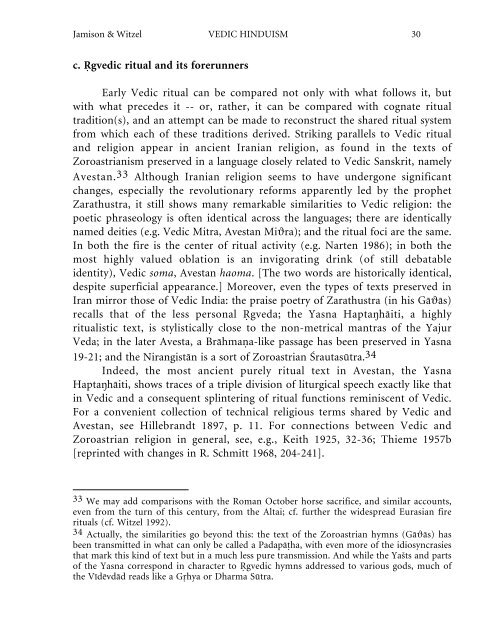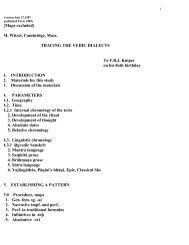VEDIC HINDUISM by S. W. Jamison and M. Witzel - people.fas ...
VEDIC HINDUISM by S. W. Jamison and M. Witzel - people.fas ...
VEDIC HINDUISM by S. W. Jamison and M. Witzel - people.fas ...
You also want an ePaper? Increase the reach of your titles
YUMPU automatically turns print PDFs into web optimized ePapers that Google loves.
<strong>Jamison</strong> & <strong>Witzel</strong> <strong>VEDIC</strong> <strong>HINDUISM</strong> 30<br />
c. �gvedic ritual <strong>and</strong> its forerunners<br />
Early Vedic ritual can be compared not only with what follows it, but<br />
with what precedes it -- or, rather, it can be compared with cognate ritual<br />
tradition(s), <strong>and</strong> an attempt can be made to reconstruct the shared ritual system<br />
from which each of these traditions derived. Striking parallels to Vedic ritual<br />
<strong>and</strong> religion appear in ancient Iranian religion, as found in the texts of<br />
Zoroastrianism preserved in a language closely related to Vedic Sanskrit, namely<br />
Avestan.33 Although Iranian religion seems to have undergone significant<br />
changes, especially the revolutionary reforms apparently led <strong>by</strong> the prophet<br />
Zarathustra, it still shows many remarkable similarities to Vedic religion: the<br />
poetic phraseology is often identical across the languages; there are identically<br />
named deities (e.g. Vedic Mitra, Avestan Miθra); <strong>and</strong> the ritual foci are the same.<br />
In both the fire is the center of ritual activity (e.g. Narten 1986); in both the<br />
most highly valued oblation is an invigorating drink (of still debatable<br />
identity), Vedic soma, Avestan haoma. [The two words are historically identical,<br />
despite superficial appearance.] Moreover, even the types of texts preserved in<br />
Iran mirror those of Vedic India: the praise poetry of Zarathustra (in his Gåθås)<br />
recalls that of the less personal �gveda; the Yasna Hapta�håiti, a highly<br />
ritualistic text, is stylistically close to the non-metrical mantras of the Yajur<br />
Veda; in the later Avesta, a Bråhma�a-like passage has been preserved in Yasna<br />
19-21; <strong>and</strong> the Nirangistån is a sort of Zoroastrian Śrautasūtra.34<br />
Indeed, the most ancient purely ritual text in Avestan, the Yasna<br />
Hapta�håiti, shows traces of a triple division of liturgical speech exactly like that<br />
in Vedic <strong>and</strong> a consequent splintering of ritual functions reminiscent of Vedic.<br />
For a convenient collection of technical religious terms shared <strong>by</strong> Vedic <strong>and</strong><br />
Avestan, see Hillebr<strong>and</strong>t 1897, p. 11. For connections between Vedic <strong>and</strong><br />
Zoroastrian religion in general, see, e.g., Keith 1925, 32-36; Thieme 1957b<br />
[reprinted with changes in R. Schmitt 1968, 204-241].<br />
33 We may add comparisons with the Roman October horse sacrifice, <strong>and</strong> similar accounts,<br />
even from the turn of this century, from the Altai; cf. further the widespread Eurasian fire<br />
rituals (cf. <strong>Witzel</strong> 1992).<br />
34 Actually, the similarities go beyond this: the text of the Zoroastrian hymns (Gåθås) has<br />
been transmitted in what can only be called a Padapå�ha, with even more of the idiosyncrasies<br />
that mark this kind of text but in a much less pure transmission. And while the Yašts <strong>and</strong> parts<br />
of the Yasna correspond in character to �gvedic hymns addressed to various gods, much of<br />
the Vīdẽvdåd reads like a G�hya or Dharma Sūtra.

















